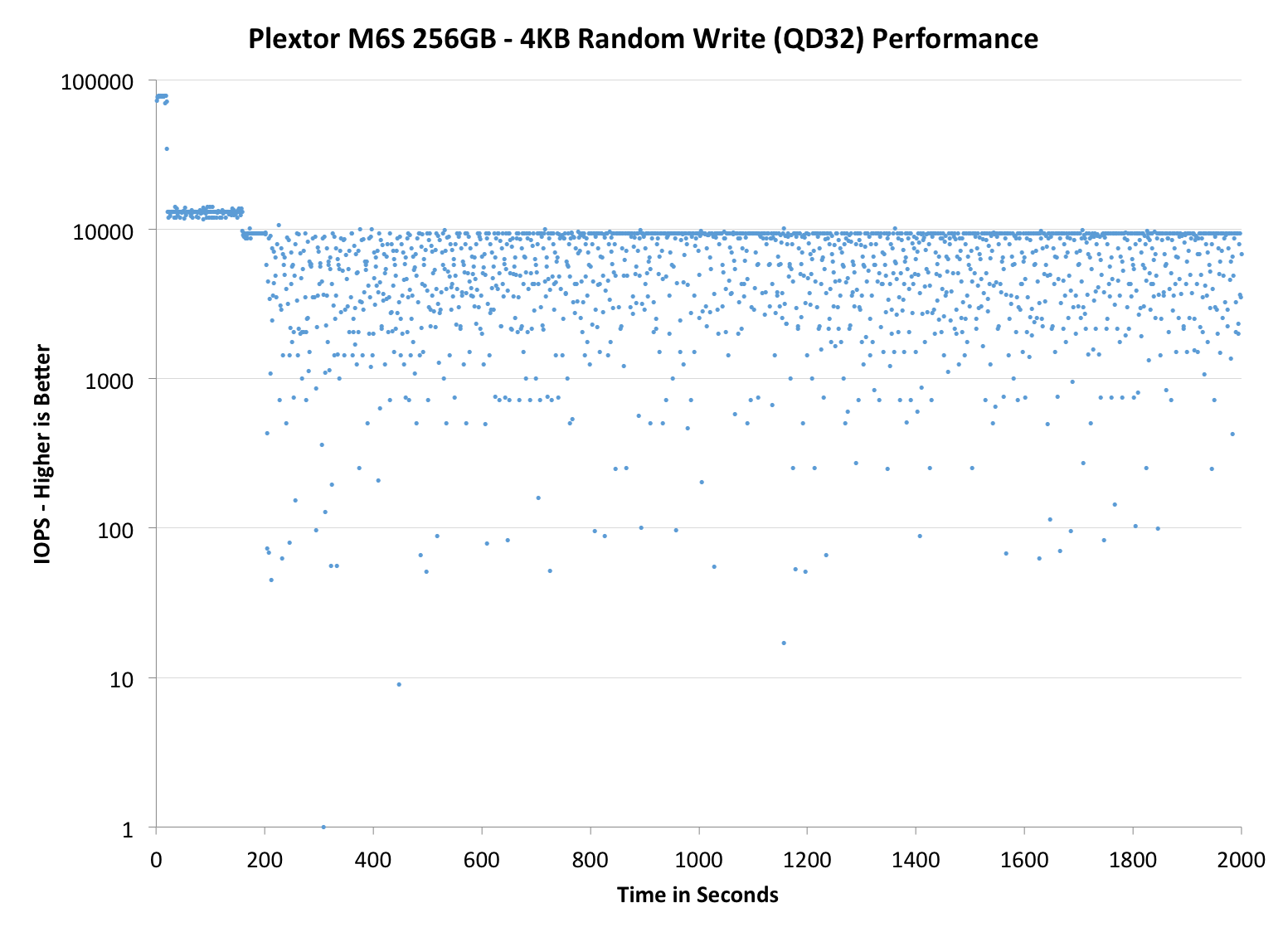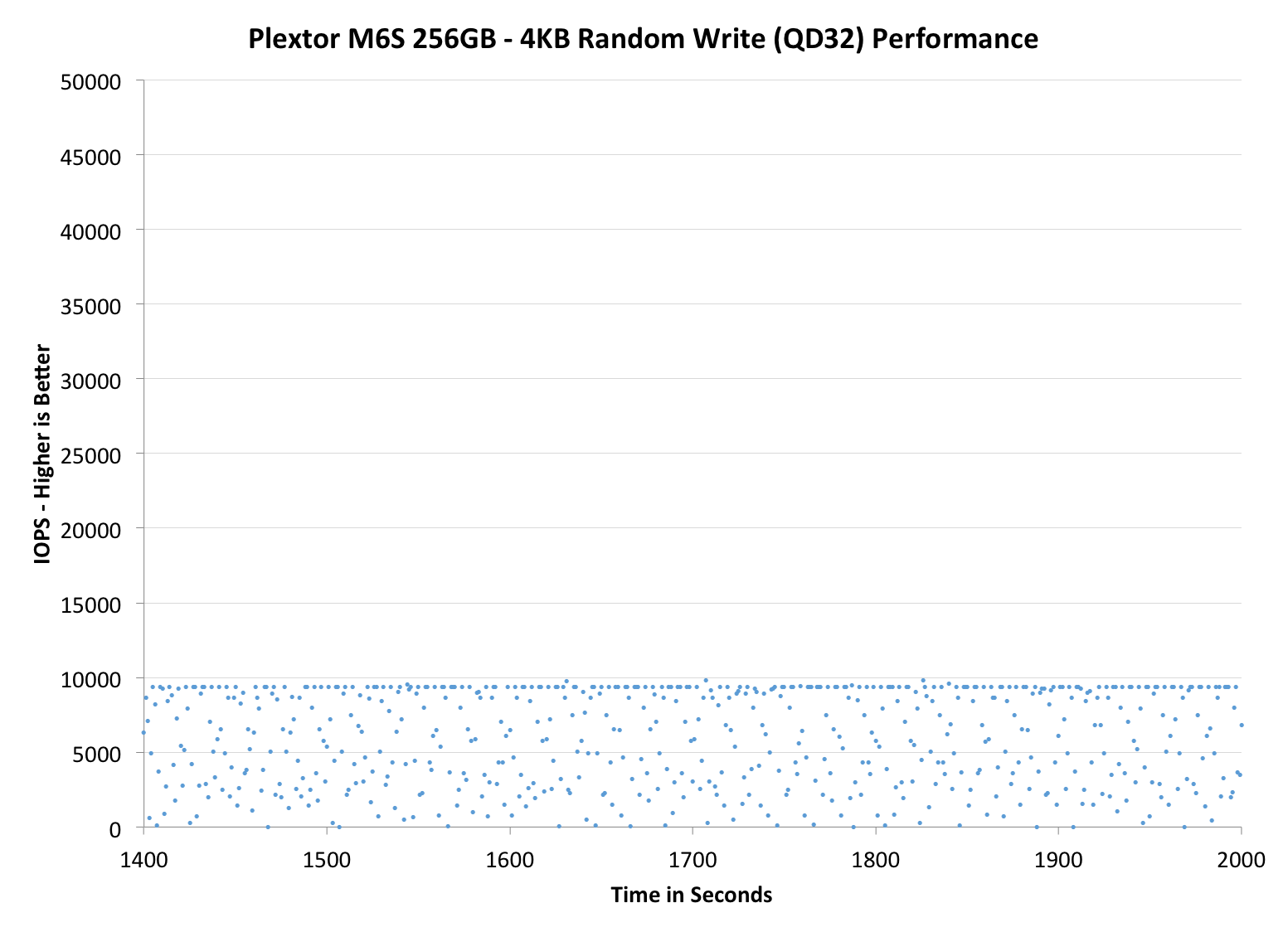Plextor M6S & M6M (256GB) Review
by Kristian Vättö on April 10, 2014 6:00 AM ESTPerformance Consistency
Performance consistency tells us a lot about the architecture of these SSDs and how they handle internal defragmentation. The reason we don’t have consistent IO latency with SSD is because inevitably all controllers have to do some amount of defragmentation or garbage collection in order to continue operating at high speeds. When and how an SSD decides to run its defrag or cleanup routines directly impacts the user experience as inconsistent performance results in application slowdowns.
To test IO consistency, we fill a secure erased SSD with sequential data to ensure that all user accessible LBAs have data associated with them. Next we kick off a 4KB random write workload across all LBAs at a queue depth of 32 using incompressible data. The test is run for just over half an hour and we record instantaneous IOPS every second.
We are also testing drives with added over-provisioning by limiting the LBA range. This gives us a look into the drive’s behavior with varying levels of empty space, which is frankly a more realistic approach for client workloads.
Each of the three graphs has its own purpose. The first one is of the whole duration of the test in log scale. The second and third one zoom into the beginning of steady-state operation (t=1400s) but on different scales: the second one uses log scale for easy comparison whereas the third one uses linear scale for better visualization of differences between drives. Click the buttons below each graph to switch the source data.
For more detailed description of the test and why performance consistency matters, read our original Intel SSD DC S3700 article.
 |
|||||||||
| Plextor M6S | Plextor M5M | Crucial M550 | SanDisk Extreme II | Samsung SSD 840 EVO mSATA | |||||
| Default | |||||||||
| 25% Spare Area | |||||||||
Ouch, this doesn't look too good. The IOPS is constantly dropping below 1000, which is something I'm not expecting to see anymore. Even the M550 can keep the IOPS at ~4000 minimum, so the M6S certainly doesn't do well here. With added over-provisioning (OP) the performance does look a lot better and the minimum IOPS jumps to ~10K but it's still a downgrade from the M5M. Given the change to a lighter controller this is perhaps expected, but I'm still worried about the consistency without additional OP. I would make sure to leave ~10-15% of empty space with the M6S and M6M to avoid running into inconsistent performance.
 |
|||||||||
| Plextor M6S | Plextor M5M | Crucial M550 | SanDisk Extreme II | Samsung SSD 840 EVO mSATA | |||||
| Default | |||||||||
| 25% Spare Area | |||||||||
 |
|||||||||
| Plextor M6S | Plextor M5M | Crucial M550 | SanDisk Extreme II | Samsung SSD 840 EVO mSATA | |||||
| Default | |||||||||
| 25% Spare Area | |||||||||










30 Comments
View All Comments
prime2515103 - Thursday, April 10, 2014 - link
I find it disappointing how average Plextor has become, yet they keep their pricing at a point where one might expect to get something at least slightly exceptional.I do have an M5M in my laptop and haven't had any problems with it, so I'll give them that. The selection of mSATA drives was pretty sparse when I bought it though, and it was on sale for $108 (which was quite good at the time), otherwise it definitely would not have been my first choice.
Cellar Door - Thursday, April 10, 2014 - link
I agree, I will be going with samsung evo for my msata drive. Very disappointing for the price.Samus - Thursday, April 10, 2014 - link
M500 is still the best deal for an average, reliable SSD. Great for basic business and family PC's.rufuselder - Thursday, October 9, 2014 - link
Me too. But either way, there are some much better storage options out there. /Rufus from http://www.consumertop.com/best-computer-storage-g...dylan522p - Thursday, April 10, 2014 - link
That was good basic explanation of the differences between everyones NAND! Thanks for doing that.nathanddrews - Thursday, April 10, 2014 - link
The pictures of the IMFT and Samsung processes are all clean and uniform... the Toshiba and Hynix processes look like a 3-year-old with a crayon made them.zodiacsoulmate - Thursday, April 10, 2014 - link
yea... why they look like that? maybe they are hard to color? why they look so random...extide - Thursday, April 10, 2014 - link
LOL, I noticed that too, it's like, geez how does that stuff even work! Looks so sloppy!Kristian Vättö - Friday, April 11, 2014 - link
Keep in mind that the diameter of the photo is a few dozen nanometers and it's extremely hard to achieve 100% precision with lithographies that small. At least IMFT has been using air gaps before and it's a mature process for them but Toshiba and Hynix added them to the current generation, making it quite new for them.creed3020 - Thursday, April 10, 2014 - link
Kristian thanks for such an in-depth technical and product review. I really appreciate how in your reviews graphs are accompanied with text explaining the results and providing an opinion on the results. I can read a graph but interpretation of those graphs and data trends is often missing from reviews here at AT.I am surprised that such a new drive isn't also available in M2 format but I guess they have the M6e for that. Is there a review of that drive coming as well?